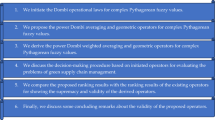Abstract
The existing assignment problems for assigning n jobs to n individuals are limited to the considerations of cost or profit measured as crisp. However, in many real applications, costs are not deterministic numbers. This paper develops a procedure based on Data Envelopment Analysis method to solve the assignment problems with fuzzy costs or fuzzy profits for each possible assignment. It aims to obtain the points with maximum membership values for the fuzzy parameters while maximizing the profit or minimizing the assignment cost. In this method, a discrete approach is presented to rank the fuzzy numbers first. Then, corresponding to each fuzzy number, we introduce a crisp number using the efficiency concept. A numerical example is used to illustrate the usefulness of this new method.
Similar content being viewed by others
References
Avis D and Devroye L (1985). An analysis of a decomposition heuristic for the assignment problem. Opns Res Lett 3 (6): 279–283.
Balinski ML (1986). A competitive (dual) simplex method for the assignment problem. Math Program 34: 125–141.
Bellman RE and Zadeh LA (1970). Decision-making in a fuzzy environment. Mngt Sci 17B: 141–164.
Charnes A, Cooper WW and Rhodes E (1978). Measuring the efficiency of decision making units. Eur J Opl Res 2: 429–444.
Chen LH and Lu H.W (2007). An extended assignment problem considering multiple inputs and outputs. Appl Math Model 31: 2239–2248.
Eberhardt SP, Duad T, Kerns DA, Brown TX and Thakoor AP (1991). Competitive neural architecture for hardware solution to the assignment problem. Neur Networks 4: 431–442.
Emrouznejad A, Parker B and Tavares G (2008). Evaluation of research in efficiency and productivity: A survey and analysis of the first 30 years of scholarly literature in DEA. J Socio-Econ Plann Sci 42: 151–157.
Emrouznejad A and De Witte K (2010). COOPER-framework: A unified process for non-parametric projects. Eur J Opl Res 207: 1573–1586.
Konig D (1950). Theorie der Endlichen und Unendlichen Graphen, Akad. Verl. M. B. H., Leipzig, 1936, Chelsea Publ. Co., New York.
Kuhn HW (1955). The Hungarian method for the assignment problem. Naval Res Logist Quart 2: 83–97.
Lin CJ and Wen UP (2004). A labeling algorithm for the fuzzy assignment problem. Fuzzy Sets Syst 142: 373–391.
McGinnis LF (1983). Implementation and testing of a primal-dual algorithm for the assignment problem. Opns Res 31: 277–291.
Zerafat Angiz L M, Emrouznejad A, Mustafa A and Komijan AR (2009). Selecting the most preferable alternatives in a group decision making problem using DEA. Expert Syst Appl 36: 9599–9602.
Zerafat Angiz L M, Saati SM and Mokhtaran M (2003). An alternative approach to assignment problem with non-homogeneous costs using common set of weights in DEA. Far East J Appl Math l0 (1): 29–39.
Author information
Authors and Affiliations
Corresponding author
Rights and permissions
About this article
Cite this article
Emrouznejad, A., Zerafat Angiz L, M. & Ho, W. An alternative formulation for the fuzzy assignment problem. J Oper Res Soc 63, 59–63 (2012). https://doi.org/10.1057/jors.2011.14
Received:
Accepted:
Published:
Issue Date:
DOI: https://doi.org/10.1057/jors.2011.14




